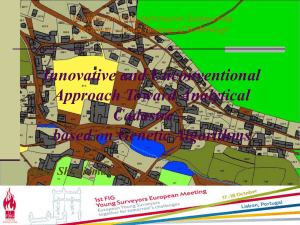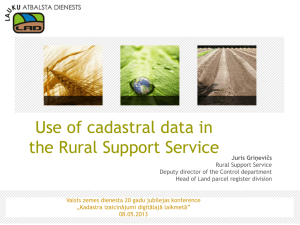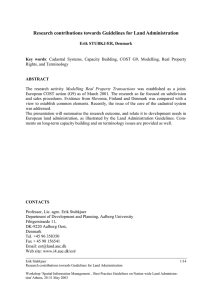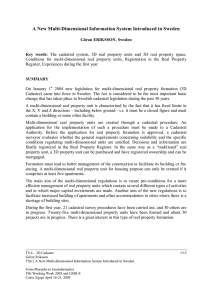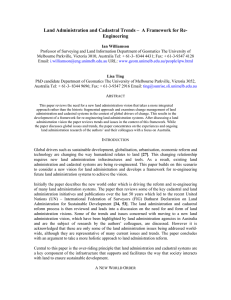Representation and Management of Spatial Error in Cadastral Databases Dr. Panos Lolonis
advertisement
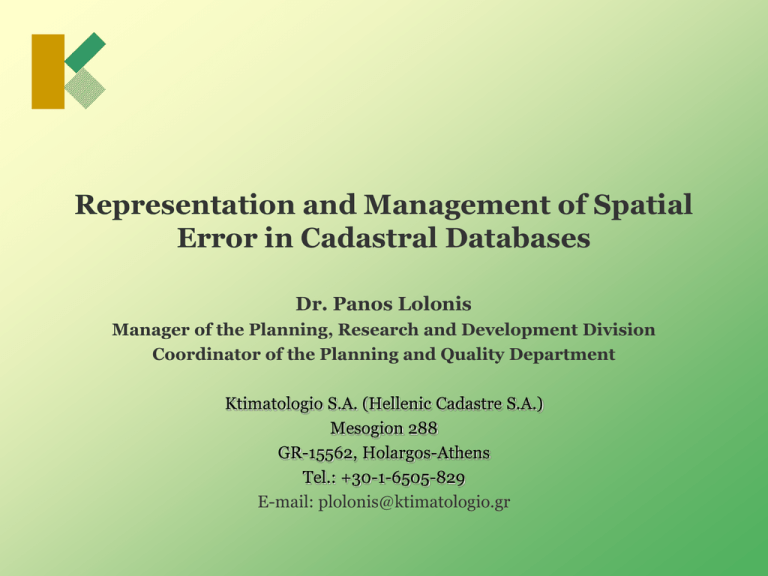
Representation and Management of Spatial Error in Cadastral Databases Dr. Panos Lolonis Manager of the Planning, Research and Development Division Coordinator of the Planning and Quality Department Ktimatologio S.A. (Hellenic Cadastre S.A.) Mesogion 288 GR-15562, Holargos-Athens Tel.: +30-1-6505-829 E-mail: plolonis@ktimatologio.gr Outline Conventional approach for handling spatial cadastral data Shortcomings of the traditional approach Representation of spatial cadastral data and their accuracy Management of data and their accuracy Use of stochastic spatial data in land management activities Conclusions Conventional Approach for Handling Spatial Cadastral Data Lack of accuracy about the locations of cadastral data Use of data in deterministic fashion Consequences and shortcomings Lack of specificity about the level of accuracy (“more or less”) Inconsistencies among different series of measurements Inconsistencies among values of documents Problems in the use of cadastral data in applications (zoning regulations, tax agencies) Importance of accurate locational cadastral data Extract from a Contract Definition of the size and dimensions of the parcel Cadastral Map Land parcels in a city block Cadastral Extract of a Land Parcel Cadastral Extract Sent to Owners Differences between Declared and Computed Areas 60 A’ Pilot Program The Hellenic Cadastre Project 40 Urban 30 Municipalities: Urban: Chalandri Rural 20 Rural: Megas Alexandros 10 Category > (50) (20) - (50) (10) - (20) (5) - (10) (2) - (5) (-2) - (2) (-5) - (-2) (-10) - (-5) (-20) - (-10) (-50) - (-20) 0 < (-50) Percent (%) 50 Public Opinion about the Benefits of the Hellenic Cadastre Category 70 • Percent of responses (%) 60 50 • • • • • • 40 30 20 10 Settlement of the boundaries of the properties of individuals Protection from land infringement Determination of public land Facilitation of land transactions Protection of forests No benefits No answer 0 1 2 3 4 Category 5 6 7 Sample size: 1495 Date: December 1999 Representation of Spatial Cadastral Data and Their Accuracy Tag standard errors and covariances to the coordinate data Computation of derivative variables and their accuracy Lengths Areas Angles (Use of the Error Propagation Law) Need to incorporate functions into computer-based cadastral systems to handle error Locational Accuracy of Points, Sides and Areas of Land Parcels Area = 1854.84 m2 (1834.64 – 1875.03) Management of Data and their Accuracy Adoption of the stochastic framework provides new flexible ways to deal with problems and procedures requires a different approach to carry-out land administration tasks Procedures for updating data Testing about the coincidence of old and new data Amalgamate old and new information Use of Stochastic Spatial Data in Land Management Activities Compilation of legal documents (contracts) Incorporate expected values, confidence intervals and confidence levels into documents and diagrams Satisfying zoning regulations (Test hypotheses) :Areas Ho: Area >= 400 m2 H1: Area < 400 m2 the 95% confidence level Lengths Ho: Length >= 15 m the 95% confidence level H1: Length < 15 m at at Resolving boundary disputes Need to reform legislation to incorporate the stochastic notions (expected values, standards errors, confidence levels) Conclusions Accuracy information must be explicitly incorporated and handled into cadastral databases Cadastral data that incorporate accuracy measures are more informative and more useful in land management activities There is a need to promote development of: GIS software that can handle probabilistic data Legislation that is in conformance with probabilistic reasoning Goal: To develop cadastral systems that combine data about location, accuracy and time in a tightly integrated framework.




